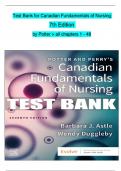Exam (elaborations)
Potter and Perry's Canadian Fundamentals of Nursing 7th Edition Test Bank by Barbara Astle, All 48 Chapters Covered and Verified, ISBN: 9780323870658
- Course
- Institution
- Book
Potter and Perry's Canadian Fundamentals of Nursing 7th Edition Test Bank by Barbara Astle, All 48 Chapters Covered and Verified, ISBN: 9780323870658 Potter and Perry's Canadian Fundamentals of Nursing 7th Edition Test Bank by Barbara Astle, All 48 Chapters Covered and Verified, ISBN: 978032387065...
[Show more]



